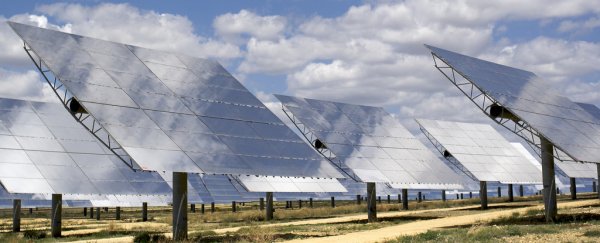It's official: solar became the cheapest source of new energy in lower-income countries this year, giving both companies and governments alike another reason to ditch coal and gas for renewables.
Data from Bloomberg New Energy Finance (BNEF) show that the average price of solar energy in almost 60 countries dropped to US$1.65 million per megawatt during 2016, just below wind at US$1.66 million per megawatt.
That's based on average prices across 58 emerging markets, including China, India, and Brazil, and it means renewable energy will be an increasingly attractive way to go for companies investing in new power plants in the future.
"Solar investment has gone from nothing … five years ago to quite a lot," BNEF analyst Ethan Zindler told Tom Randall at Bloomberg. "A huge part of this story is China, which has been rapidly deploying solar."
 Bloomberg
Bloomberg
Last year, China invested $103 billion in solar projects, more than the US ($44.1 billion), the UK ($22.2 billion), and Japan ($36.2 billion) put together.
Prices have also been dropping at auctions, where private firms bid against each other for big electricity contracts.
In January, a new record was hit in India with a contract to supply solar power for $64 per megawatt-hour (MWh), and by August, that had dropped all the way to $29.10 per megawatt-hour.
For a bit of context, megawatt-hours (and kilowatt-hours) are units of energy, whereas megawatts (and kilowatts) are units of power – the rate at which energy is consumed.
If you're in a car, the energy value would be equivalent to the distance you'd travelled, and the power value would be the speed you were travelling at.
In terms of that sub-$30 MWh figure for solar, it's roughly half the price of paying for coal – and when you factor in the benefit of reducing global carbon emissions, it seems like a no-brainer.
"Renewables are robustly entering the era of undercutting [fossil fuels]," says BNEF chairman, Michael Liebreich.
Solar is booming for a number of reasons, including falling equipment costs, new business models like Tesla's home batteries, growing investment, and a rise in clean energy policies.
It's also worth noting that prices fluctuate across the world, and solar isn't the cheapest deal everywhere just yet – the cost depends on sunshine availability, plus the energy contracts that are already in place, and what government subsidies are on offer.
But it's still a landmark moment for new energy costs in developing nations, and goes hand-in-hand with renewable energy now having become the largest source of new power capacity in the world.
We've seen some amazing milestones set this year, which gives us plenty of optimism for the future: on one particular Sunday, Scotland generated all of its energy needs through wind power alone, while Portugal stayed powered up on renewables for four days straight.
Fossil fuels won't disappear overnight, but here's hoping that dropping prices, more efficient technology, and government commitments can change our energy landscape for the better.
